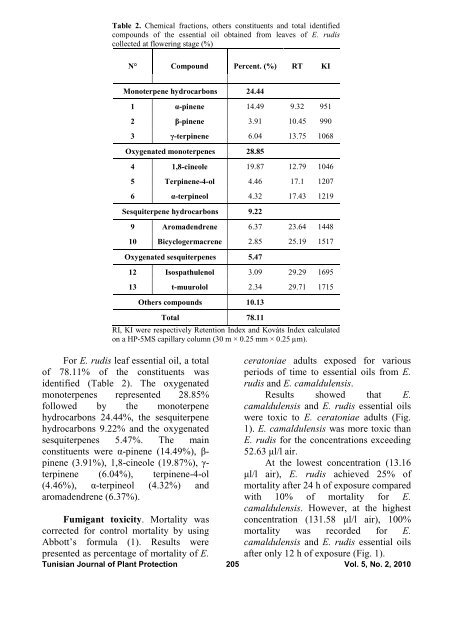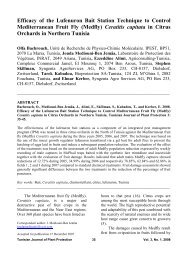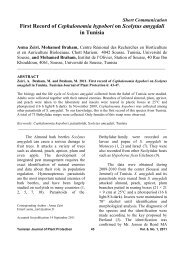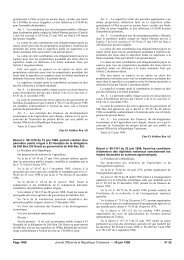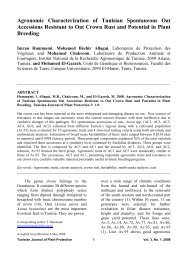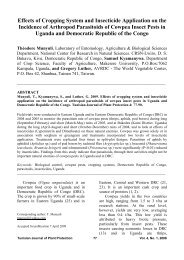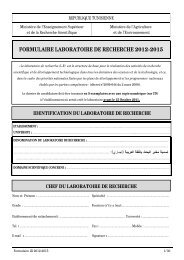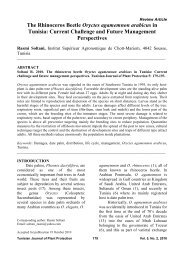Postharvest Control of the Date Moth Ectomyelois ceratoniae ... - Iresa
Postharvest Control of the Date Moth Ectomyelois ceratoniae ... - Iresa
Postharvest Control of the Date Moth Ectomyelois ceratoniae ... - Iresa
You also want an ePaper? Increase the reach of your titles
YUMPU automatically turns print PDFs into web optimized ePapers that Google loves.
Table 2. Chemical fractions, o<strong>the</strong>rs constituents and total identifiedcompounds <strong>of</strong> <strong>the</strong> essential oil obtained from leaves <strong>of</strong> E. rudiscollected at flowering stage (%)N° Compound Percent. (%) RT KIMonoterpene hydrocarbons 24.441 α-pinene 14.49 9.32 9512 β-pinene 3.91 10.45 9903 γ-terpinene 6.04 13.75 1068Oxygenated monoterpenes 28.854 1,8-cineole 19.87 12.79 10465 Terpinene-4-ol 4.46 17.1 12076 α-terpineol 4.32 17.43 1219Sesquiterpene hydrocarbons 9.229 Aromadendrene 6.37 23.64 144810 Bicyclogermacrene 2.85 25.19 1517Oxygenated sesquiterpenes 5.4712 Isospathulenol 3.09 29.29 169513 t-muurolol 2.34 29.71 1715O<strong>the</strong>rs compounds 10.13Total 78.11RI, KI were respectively Retention Index and Kováts Index calculatedon a HP-5MS capillary column (30 m × 0.25 mm × 0.25 µm).For E. rudis leaf essential oil, a total<strong>of</strong> 78.11% <strong>of</strong> <strong>the</strong> constituents wasidentified (Table 2). The oxygenatedmonoterpenes represented 28.85%followed by <strong>the</strong> monoterpenehydrocarbons 24.44%, <strong>the</strong> sesquiterpenehydrocarbons 9.22% and <strong>the</strong> oxygenatedsesquiterpenes 5.47%. The mainconstituents were α-pinene (14.49%), β-pinene (3.91%), 1,8-cineole (19.87%), γ-terpinene (6.04%), terpinene-4-ol(4.46%), α-terpineol (4.32%) andaromadendrene (6.37%).<strong>ceratoniae</strong> adults exposed for variousperiods <strong>of</strong> time to essential oils from E.rudis and E. camaldulensis.Results showed that E.camaldulensis and E. rudis essential oilswere toxic to E. <strong>ceratoniae</strong> adults (Fig.1). E. camaldulensis was more toxic thanE. rudis for <strong>the</strong> concentrations exceeding52.63 µl/l air.At <strong>the</strong> lowest concentration (13.16µl/l air), E. rudis achieved 25% <strong>of</strong>mortality after 24 h <strong>of</strong> exposure comparedwith 10% <strong>of</strong> mortality for E.camaldulensis. However, at <strong>the</strong> highestconcentration (131.58 µl/l air), 100%mortality was recorded for E.camaldulensis and E. rudis essential oilsFumigant toxicity. Mortality wascorrected for control mortality by usingAbbott’s formula (1). Results werepresented as percentage <strong>of</strong> mortality <strong>of</strong> E. after only 12 h <strong>of</strong> exposure (Fig. 1).Tunisian Journal <strong>of</strong> Plant Protection 205 Vol. 5, No. 2, 2010


